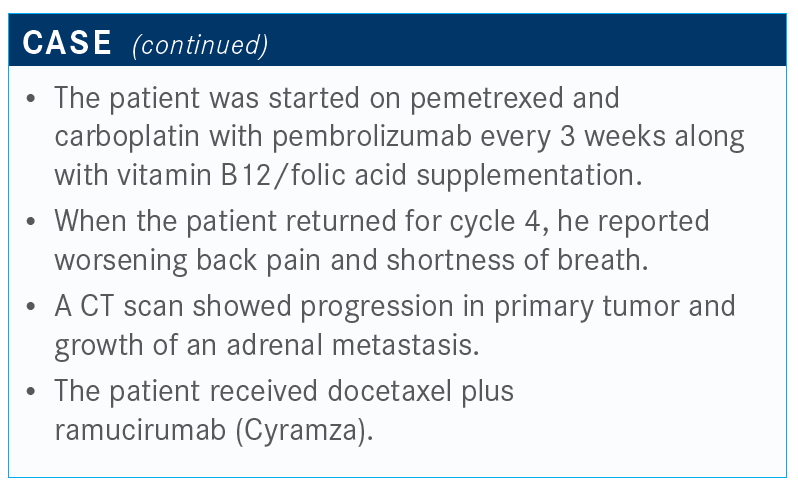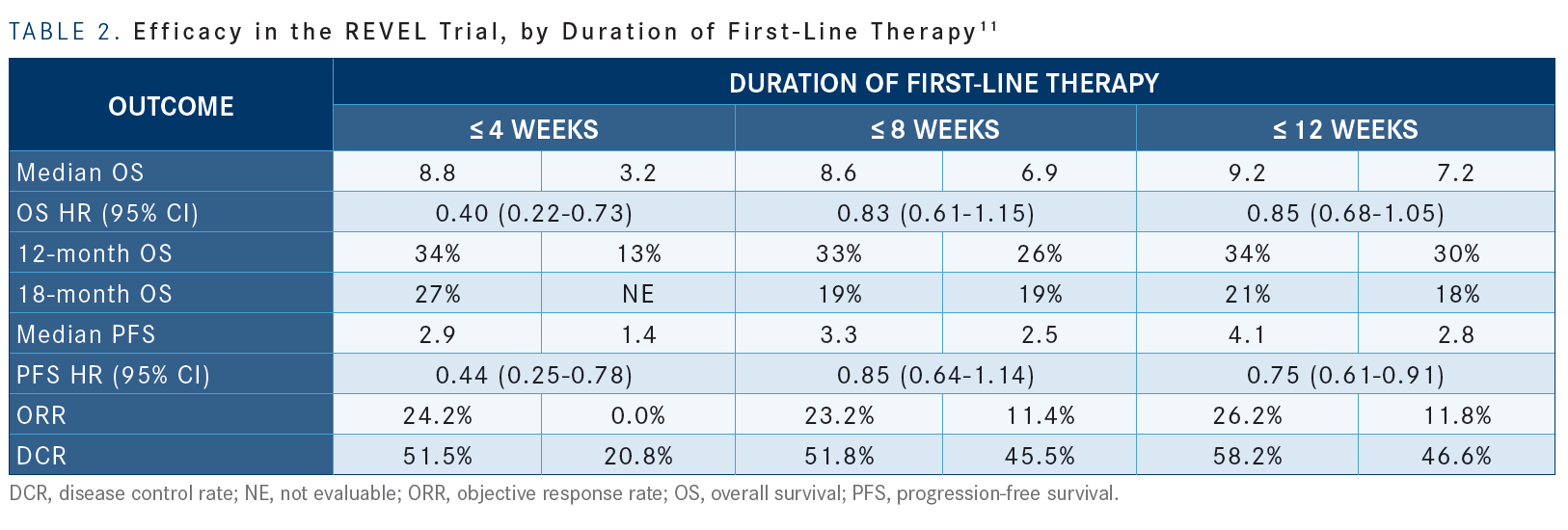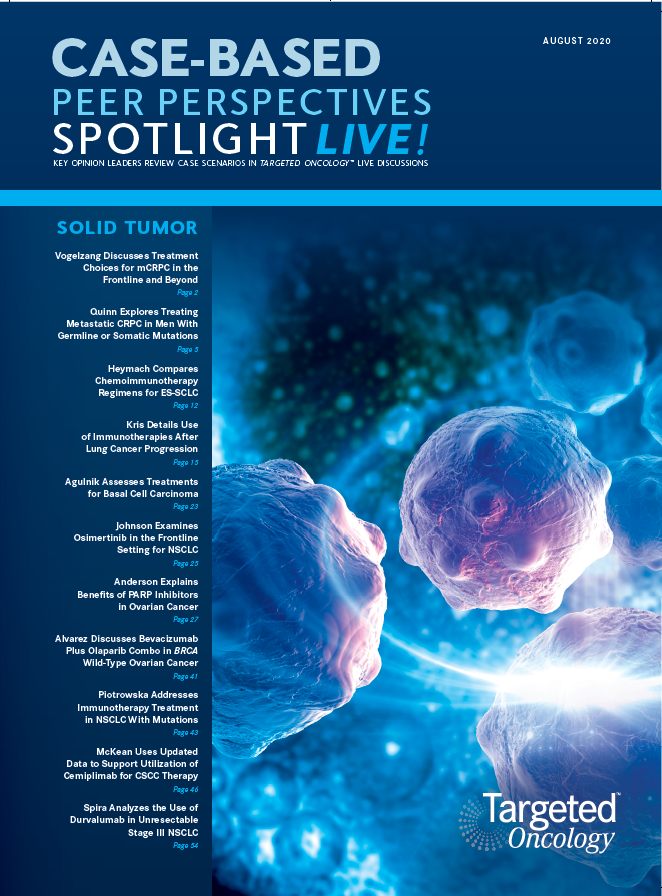Kris Details Use of Immunotherapies After Lung Cancer Progression
During a virtual Case Based Peer Perspectives event, Mark G. Kris, MD, attending physician, Thoracic Oncology Service, William and Joy Ruane chair in Thoracic Oncology, Memorial Sloan Kettering Cancer Center, discussed molecular testing for a 59-year-old patient with poorly differentiated adenocarcinoma of the lung, as wells as the treatment options for the patient.
Mark G. Kris, MD

During a virtual Case Based Peer Perspectives event, Mark G. Kris, MD, attending physician, Thoracic Oncology Service, William and Joy Ruane chair in Thoracic Oncology, Memorial Sloan Kettering Cancer Center, discussed molecular testing for a 59-year-old patient with poorly differentiated adenocarcinoma of the lung, as wells as the treatment options for the patient.

Targeted Oncology™: What type of molecular testing would you obtain in a patient such as this one?
Kris: Getting the tissue [test results] from other institutions is difficult, and I’m impatient. But our patients wait forever for this. I think having the liquid biopsy is something you can do. I tend
to send both [tissue and plasma], and whichever one gets in first wins, but I don’t know if that’s the best strategy.
My perspective is that it’s nice to biopsy a metastatic site and confirm that it’s lung cancer in a metastatic site. You’ve confirmed the diagnosis of cancer, you’ve confirmed lung cancer by perhaps a special stain, and you’ve confirmed the presence of metastasis.
I don’t know if [other physicians] spend as much time looking at the NCCN [National Comprehensive Cancer Network] Guidelines as I do and notice that they change week to week right now. But the current NCCN Guidelines…have added in RET and MET exon 14 [to the list of mutations to test for]. The reason for that is drugs were specifically approved for those aberrations; selpercatinib [Retevmo] for the RET1 and capmatinib [Tabrecta] for the MET exon 14.2
To me, now that we have 6 molecular targets [recommended for reflex testing], it doesn’t make sense to do more than 1 test.

What treatment options are available to this patient without oncogenic driver mutations?
I’m a big fan of the PFS [progression-free survival] benefit for pembrolizumab [Keytruda] added to the chemotherapy combination in the KEYNOTE-189 trial [NCT02578680]. Interestingly, you see some degree of benefit [versus chemotherapy alone] with each grouping of PD-L1 positivity of less than 1%, 1% to 49%, and greater than 50%. The higher the PD-L1 expression, the higher the PFS curve for the pembrolizumab-containing regimen. Even for the PD-L1 less than 1% group [HR, 0.75; 95% CI, 0.53-1.05], there is still benefit from the triplet drug.3
To me, the most amazing thing about checkpoint inhibitors is that in some patients, the cancer goes away and never comes back. All of those people are on the PFS curve, and to me the higher the PFS curve, the higher the chance of getting 1 of those coveted spots where your metastatic cancer remains under control 5 years later. There really is no tail on the curve with chemotherapy.
[There was also a] benefit for overall survival, again favoring the triplet over the standard chemotherapy combination.4
Unfortunately, some of those people on the curve have relapsed already. They are still alive, but they’re not going to be those who have the really long survival.
When would you consider using pembrolizumab plus chemotherapy versus alone in a patient such as this one?
Response data show the same kind of trend by PD-L1 status. In addition to the benefits we talked about with PFS…this speaks to me as who needs the chemotherapy. And that is when you have patients who are more symptomatic than in our case; you need to think about giving that triplet. Even for the patients with high PD-L1 expression who you might even think about giving pembrolizumab alone, I think for that very symptomatic patient, you would want to give chemotherapy with it because you know you’re going to have a chance for an increased response rate, and that response would mean a lot for that patient who has lifestyle- limiting dyspnea or bone pain [TABLE 1].4
What other trials look at pembrolizumab in this setting?
What you see [in KEYNOTE-042 (NCT02220894)] is that rates of response, chemotherapy versus pembrolizumab, are comparable. The highest rate of response is with the highest PD-L1 expression group. You see the lowest response rate in the low PD-L1 category.5
I don’t read too much into this trial other than in patients with higher PD-L1, there’s a place for the single agent. But to me, this trial doesn’t guide me to answer the question that people have been asking: Who do you decide to give chemotherapy?
Are there other immunotherapy combinations that do not contain pembrolizumab that you could use for this patient?
The IMpower150 [NCT02366143] trial had 3 different treatment arms. [Investigators compared] the 4-drug regimen [atezolizumab (Tecentriq), bevacizumab (Avastin), carboplatin, and paclitaxel] with the 3-drug regimen [bevacizumab, carboplatin, and paclitaxel].6
Do you use bevacizumab for lung cancer anymore?
We get a lot of requests [for it from] our neurologic colleagues. I don’t know if other folks have this experience, but more often than not, it’s the neurologist who asks for bevacizumab for…the radionecrosis and edema. The other interesting thing is, I don’t know how they do it, they seem to get bevacizumab, as a single agent, [covered by insurance] for radionecrosis. The other thing about bevacizumab is it does help with pleural effusions and ascites.
I think we’ve all moved on from bevacizumab, and we’ve moved on from this regimen because of bevacizumab and the paclitaxel.
Where would the 4-drug IMpower150 regimen fit into practice?
The one thing on the IMpower150 trial [is that] this regimen is out there as being one for use in patients with EGFR-mutant cancer. I’ve seen some presentations doing a deep dive on the data. It’s one of the few regimens with an immunotherapy drug that has been given to patients with EGFR mutations.
Could you use at PD-1/CTLA-4 inhibitor combination for this patient?
You can look at ipilimumab [Yervoy] plus nivolumab [Opdivo] versus chemotherapy in the CheckMate 227 trial [NCT02477826].
Ipilimumab plus nivolumab is better than chemotherapy, particularly for high PD-L1 expression. A 3-year update showed that ipilimumab plus nivolumab is better than nivolumab alone, which is better than chemotherapy [in patients with] PD-L1 expression greater than 1% and even for the low PD-L1 [< 1%].7
There were recently presented data at ASCO [American Society of Clinical Oncology] 2020 Virtual Scientific Program of chemotherapy for 2 cycles plus ipilimumab and nivolumab versus chemotherapy alone [CheckMate 9LA (NCT03215706)].8
I don’t think [these data] help me to decide what to do and how much adding in the ipilimumab plus nivolumab over nivolumab alone would make a difference. It’s hard to say. I caution you [when looking] at 2-year data. It’s early data, and I’m not sure how far it helps us in our decision-making, other than saying adding ipilimumab and nivolumab to chemotherapy makes some sense. The other interesting thing [is that the Kaplan-Meier] curves for survival cross each other a lot
This is a changing landscape. On May 26, 2020, ipilimumab and nivolumab plus chemotherapy was approved in the first line.9

What data support the use of ramucirumab for the patient at this point in their disease?
The data on the REVEL study [NCT01168973] that led to the docetaxel plus ramucirumab approval looked at was docetaxel plus ramucirumab versus docetaxel.10
This regimen was given regardless of cell type or prior taxane therapy. Though at this point, the majority of patients had not had prior taxane therapy. Regardless of stratifying for EGFR status, few patients [with mutations] were included in this cohort. One difference here compared with bevacizumab is that patients with squamous histology were treated and did not appear to raise any safety signal, unlike using other angiogenesisinhibiting drugs, such as bevacizumab, where squamous cell cancer is a contraindication.
There are data showing that patients had longer survival and better outcomes the longer they were on initial therapy, which makes sense. No matter what group you’re in, docetaxel plus ramucirumab was better than docetaxel alone. There was a consistent benefit of the docetaxel plus ramucirumab over the docetaxel alone in terms of response in survival [TABLE 2].11
Adverse effects were comparable. When you’re giving this regimen, you’re dealing with the adverse effects of docetaxel. Ways of attenuating the docetaxel adverse effects include changing the dose and schedule.10

REFERENCES:
1. FDA approves selpercatinib for lung and thyroid cancers with RET gene mutations or fusions. FDA. May 8, 2020. Accessed July 20, 2020. https://bit.ly/2OHeKUj
2. FDA grants accelerated approval to capmatinib for metastatic non-small cell lung cancer. FDA. May 6, 2020. Accessed July 20, 2020. https://bit.ly/2WF7lJp
3. Gandhi L, Rodr.guez-Abreu D, Gadgeel S, et al. Pembrolizumab plus chemotherapy in metastatic non–small-cell lung cancer. N Engl J Med. 2018;378(22):2078-2092. doi:10.1056/NEJMoa1801005
4. Rodriguez-Abreu D, Powell SF, Hochmair M, et al. Final analysis of KEYNOTE-189: Pemetrexed-platinum chemotherapy (chemo) with or without pembrolizumab (pembro) in patients (pts) with previously untreated metastatic nonsquamous non–small cell lung cancer (NSCLC). J Clin Oncol. 2020;38(suppl 15):9582. doi:10.1200/JCO.2020.38.15_suppl.9582
5. Mok TSK, Wu YL, Kudaba I, et al. Pembrolizumab versus chemotherapy for previously untreated, PD-L1-expressing, locally advanced or metastatic non–small-cell lung cancer (KEYNOTE-042): a randomised, open-label, controlled, phase 3 trial. Lancet. 2019;393(10183):1819-1830. doi:10.1016/S0140-6736(18)32409-7
6. Socinski MA, Jotte RM, Cappuzzo F, et al. Atezolizumab for first-line treatment of metastatic nonsquamous NSCLC. N Engl J Med. 2018;378(24):2288-2301. doi:10.1056/NEJMoa1716948
7. Ramalingam SS, Ciuleanu TE, Pluzanski A, et al. Nivolumab + ipilimumab versus platinum-doublet chemotherapy as fi rst-line treatment for advanced non–small cell lung cancer: Three-year update from CheckMate 227 Part 1. J Clin Oncol. 2020;38(suppl15):9500. doi:10.1200/JCO.2020.38.15_suppl.9500
8. Reck M, Ciuleanu TE, Dois MC, et al. Nivolumab (NIVO) + ipilimumab (IPI) + 2 cycles of platinum-doublet chemotherapy (chemo) vs 4 cycles chemo as fi rst-line (1L) treatment (tx) for stage IV/recurrent non–small cell lung cancer (NSCLC): CheckMate 9LA. J Clin Oncol. 2020;38(suppl 15):9501. doi:10.1200/JCO.2020.38.15_suppl.9501
9. FDA approves nivolumab plus ipilimumab and chemotherapy for first-line treatment of metastatic NSCLC. FDA. May 26, 2020. Accessed July 20, 2020. https://bit.ly/2E4b4dh
10. Garon EB, Ciuleanu TE, Arrieta O, et al. Ramucirumab plus docetaxel versus placebo plus docetaxel for second-line treatment of stage IV non–small-cell lung cancer after disease progression on platinum-based therapy (REVEL): a multicentre, double-blind, randomised phase 3 trial. Lancet. 2014;384(9944):665-673. doi:10.1016/S0140-6736(14)60845-X
11. Reck M, Paz-Ares L, Bidoli P, et al. Outcomes in patients with aggressive or refractory disease from REVEL: A randomized phase III study of docetaxel with ramucirumab or placebo for second-line treatment of stage IV non–small-cell lung cancer. Lung Cancer. 2017;112:181-187. doi:10.1016/j.lungcan.2017.07.038

Gasparetto Explains Rationale for Quadruplet Front Line in Transplant-Ineligible Myeloma
February 22nd 2025In a Community Case Forum in partnership with the North Carolina Oncology Association, Cristina Gasparetto, MD, discussed the CEPHEUS, IMROZ, and BENEFIT trials of treatment for transplant-ineligible newly diagnosed multiple myeloma.
Read More